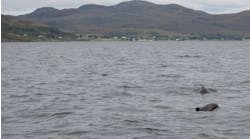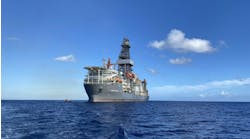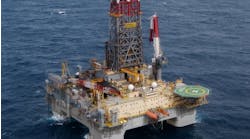GULF OF MEXICO Mexican Gulf highly productive, possible reserves as high as 700 billion bbl.
Current government promises no privatization of exploration
or production during its tenure
David ShieldsContributing Editor - Mexico CityA few years ago, at a Venezuelan geologists' conference, an executive from Amoco estimated that half a dozen oil-bearing basins in just four Latin American nations - Mexico, Venezuela, Colombia, and Brazil - could be storing 500 billion bbl of crude oil, judging from available calculations of proven and probable oil reserves.
Few would dispute that impressive figure. However, some experts consider that Mexico alone might have that kind of potential waiting to be discovered in the sedimentary basins along its shoreline and, particularly in offshore areas.
Mexico already produces about 2 million b/d and 1.4 bcf/d of natural gas in its compact offshore production area in Campeche Bay. In that area, production has centered on water depths of up to only 300 ft, with most work at around the 100 ft mark.
However, state-owned Petroleos Mexicanos (Pemex) is now setting its sights on other offshore areas, such as recent light crude discoveries on the Tabasco Littoral, as well as deepwater prospects farther out in Campeche Bay.
Recently, exploratory work has been going on near Coatzacoalcos, in Veracruz state. US firm Western Geophysical is reported to have carried out offshore seismic studies for Pemex in that area, in shallow waters just 16 miles offshore, but covering an area of 140 sq miles.
As very large areas of Mexico, both onshore and offshore, remain unexplored, several analysts believe that, by statistical extrapolation, they may well contain vast amounts of oil. Some time ago, Bernardo Grossling, a natural resources advisor for the InterAmerican Development Bank, quoted a Pemex study of over a decade ago, whose basic lines of argument are supported by Pemex officials from that period.
Pemex was able to appraise, with the information acquired on Mexico's prospective areas up to 1982, a "recoverable resource base" of world significance, namely 250 billion bbl of hydrocarbons (oil, gas, and natural gas liquids), according to Grossling.
That figure included cumulative production, proven and probable reserves and petroleum yet to be discovered. Subtracting production over the past century, the figure would be close to 220 billion. Grossling even added that possible reserves could be as high as 700 billion bbl.
Official figures of proven reserves are more sobering, but also rather comfortable, reflecting almost 50 years of reserves life at current rates of production. Proven hydrocarbon reserves stand at 63.2 billion bbl, of which 49.7 billion are of oil and condensates.
Sergio Ayala Nieto, R&D director at the Mexican Petroleum Institute, assures that official figures are coherent with international criteria for calculating proven reserves. Using probabilistic computer models, official figures reflect amounts recoverable in the future, in fields already identified, commercially viable for exploitation under foreseeable economic conditions. They do not include probable or potential reserves.
Well over a thousand oil and gas deposits have been discovered in Mexico's many sedimentary basins. Of Mexico's 63.2 billion bbl of hydrocarbon reserves, 45 billion are to be found in 250 deposits corresponding to the Cretaceous period. From the Tertiary period, 940 deposits have been discovered and hold 18 billion bbl of proven reserves. From the much more ancient Jurassic age, 25 deposits have been discovered with proven reserves of 300 million bbl.
Mexico successfully spudded its first offshore wildcat, Chac-1, in 1976. It was drilled to a depth of 11,600 ft and provided 9,500 b/d of 21° API crude oil. Soon after, Akal and Nohoch Fields were discovered, which are deposits juxtaposed to Chac, forming a single giant unit for the purposes of its exploitation. this vast heavy-crude complex is known as Cantarell, which originally had over 29 billion bbl of proven reserves and currently still provides a daily production of a million bbl a day of heavy crude and 436 mcf/d of natural gas.
Soon thereafter, the second of the country's two giant groups of hydrocarbon deposits, the Abkatun-Pol-Chuc light crude complex was discovered, as was the smaller but significant finds known as Bacab, Och, Uech, Yum, Ku, and Ek-Balam.
Between 1979 (when offshore oil production began in Mexico) and 1994, 129 exploratory wells were drilled, 71 of which found oil and gas in 30 fields. This implies an overall success rate of 55%.
Some 455 development wells were drilled, including 39 for gas lift and other artificial life projects. Of the remaining 416, production was achieved in 389, giving a 94% success rate.
Oil has been discovered in Campeche Bay at depths ranging from 4,200 ft in Cantarell to 22,000 ft on Ayin, the field with the greatest water depth (576 ft), found in 1992 by Pemex.
At the end of 1994, total historic output in the offshore Campeche area stood at 9.03 billion bbl oil, 258 million bbl condensates, and 5.3 tcf of associated gas. Total proven hydrocarbon reserves in the offshore area stood at 29.4 billion bbl, 46.5% of Mexico's total.
Gas will be a key factor
Mexico's Cantarell complex.
Of course, such figures, whether the comfortable figure of proven reserves or the extrapolated, hypothetical figures of possible reserves, do not make it any easier or cheaper to get the oil up to the surface. Fortunately, finding costs are among the lowest in the world: under two dollars a barrel in the offshore area. However, exploration and production strategies must also take demand, prices, and other elements into account.
Natural gas production is likely to take priority over crude oil production in these strategies in the foreseeable future, as domestic demand for gas is expected to rise 6-8% annually, while oil demand, both domestically and worldwide, is expected to grow much more slowly.
The past year was a more than eloquent example of this, even if the drop in demand for oil products may be atypical for the near future. Demand for oil products in the Mexican market in 1995 fell by about 4% due to the domestic economic crisis, but demand for natural gas rose by close to 10% as gas displaced fuel oil use in Mexican industry, a process which is likely to continue over the next decade.
Raul Gonzalez Garcia, until recently Pemex's director of exploration, before taking a post in Argentina, notes that "current analysis of Mexico's sedimentary basins allows us to affirm that in areas of the country already producing, there are probable reserves of 50 tcf of natural gas in Mexico's offshore against 28.2 tcf onshore. Exploratory analysis of offshore areas has already begun and these areas will provide reserves at finding costs which will vary $0.10-0.40 per Mcf."
In the short term, according to Gonzalez, proven reserves along Mexico's continental shelf, particularly in Campeche Sound, will be developed and nearby areas will be explored. Indeed, big increases in gas production have been achieved recently on some offshore fields such as Caan, Pol, and Taratunich in Campeche Bay.
Tabasco Littoral, which has high gas-to-oil ratios as well as some non-associated gas, is expected to be a medium-term development priority. "This area has a potential of about 4.7 tcf in Cretaceous and Jurassic geological structures, at depths of between 4,300 and 6,500 meters. The exploratory risk is relatively low", says Gonzalez.
The littoral area has light crude of between 35 and 48 API, according to exploratory studies carried out earlier this year. Sinan Field is 27 miles from the town of Frontera on the Tabasco shoreline. Bolontiku, just eight miles from the coast, offers 37 crude moving up to 48 crude in Hayabil Field, adjacent to the southeast.
Looking to the long term, the Veracruz offshore area, in shallow waters near the city of Coatzacoalcos, has a potential of about 5.9 tcf in deposits corresponding to the Tertiary and Mesozoic ages. "Deposits are expected to be found between 10,000 and 22,000 meters below the seabed, but we still have little knowledge of the area and exploratory risk is considered high."
There is big, long-term potential for finding gas in the Tampico-Misantla and Salina del Istmo (Marbella) offshore basins. In these areas, exploratory drilling has been very limited, so there is no reliable estimate of potential reserves and risk is also considered high. Moreover, Mexico will need top technology to offset the impact of low gas prices and of high exploratory risk, if it is to develop such areas, says Gonzalez.
Just how soon will Mexico's offshore potential be exploited? Government authorities have stated that there will certainly be no opening to private firms in the exploration and production of oil or natural gas, whether onshore or offshore, during the present government, which means from now until the year 2000.
They will probably stick to that promise, even though they have shown their will to contract international service companies, sell the state-owned petrochemical industry, and open up national gas transmission and distribution to the private sector. the reason is that, in this nationalistic nation, where oil expropriation in 1938 is still remembered, the government has been facing very stern public opposition to its pans to privatize the petrochemical industry to the point that it may yet be forced to abandon the endeavor.
Thus, development of offshore oil and gas will likely continue to be dominated by Pemex for now, and the rate of development will be determined either by state budgets, which are usually very frugal, or by whatever stimulus world oil and gas prices might provide.
Copyright 1996 Offshore. All Rights Reserved.




